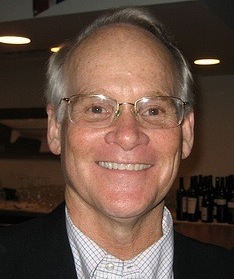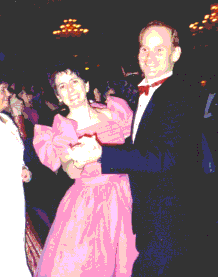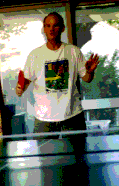 |
|
|
I created this page years ago as a way to introduce myself to Rider students (but if that doesn't describe you, you're still welcome to browse!). If you're looking for a list of publications, that's at the bottom of this page.
I've been teaching at Rider since 1992. Before that I worked as a test developer and researcher at the Educational Testing Service (in Princeton, NJ); taught middle and high school and helped run a large gifted/talented program (in Washington County, MD); developed and ran a program for adolescents at a small psychiatric hospital (in Leitersburg, MD); worked as a newspaper reporter (in Tokyo, Japan); served as an guide/interpreter for the United States Information Agency (in Osaka Japan); worked in the paint shop of a large factory (in Takamatsu, Japan); and drove a truck (throughout the Mid-Atlantic region). I liked all those jobs, but I like teaching at Rider best.
I did my undergraduate work at Yale, where I double majored in psychology and Japanese Studies (B.A., 1972, magna cum laude). I received a Ph.D. from Rutgers University in cognitive psychology in 1991.
Much of my research and writing has been in the area of creativity, and that work has been supported by generous grants from the National Science Foundation, the Educational Testing Service, the Carnegie Foundation, the National Center for Educational Statistics, and Rider and Rutgers Universities. I've won a few awards, such as the Award for Innovative Excellence in Teaching, Learning, and Technology, presented by the Eighth National Conference on College Teaching and Learning (in 1997), the Daniel E. Berlyne Award of the American Psychological Association for the year's best research in the area of creativity and/or the arts (in 1993), and the Iorio Research Award (in 2007). I was elected a fellow of the American Psychological Association, and am a member of the editorial boards of several scholarly journals, including the Journal of Creative Behavior (the oldest and most widely read creativity research journal); the American Psychological Association's newest journal, Psychology of Aesthetics, Creativity, and the Arts; and the International Journal of Thinking & Problem Solving. (For more biography, see this interview that Roeper Review published in January 2009.)
A few extracurricular interests:
I enjoy tennis, and I have a real passion for Ping-Pong. I play the guitar, and if you take one of my classes you may be subject to a singing review of the course at some point.
Three pictures:
For those of you who haven't been in my classes or met me somewhere on campus yet, here are three photos. The beautiful woman in the center is Sylvia, my wife of many years. Sylvia is a poet, a professor of English (at Gloucester County College), a writer, and the most wonderful thing that ever happened to me. Finding Sylvia (and convincing her that she had found me) was an incredible bit of luck, but it wasn't easy. She was born in Montevideo, Uruguay, and she lived there and in Sao Paulo, Brasil, before immigrating to the U.S. (as a result, English is actually her third language). Even in the U.S. we grew up in rather different worlds, she in New York City and I in the Appalachian Mountains of western Maryland. My unseen Ping-Pong opponent is our daughter Heather, who is the other most wonderful thing that ever happened to me. Heather is a tireless volunteer for 100 good causes and an all-around amazing, optimistic and upbeat person. She graduated from Hamilton College in 2000 and received her Master's degree in Special Education from Simmons College in 2003. She is currently working as a special education teacher.



An invitation:
If you've gotten this far, you know far too much about me for us not to have met, so I hope you'll stop by my office (Memorial 102) to say hello. I look forward to meeting you soon!
Disney World Course:
My wife and I occasionally teach a course at Disney World. We start with weekend meetings in New Jersey, then spend five days at Disney World. It's a three-credit course offered through my wife's college, Gloucester County College.
Disney Course: For more information about the course, click here.
Most of my research has been in the area of creativity, although I have also done work in other areas, such as cooperative learning, teacher preparation, artificial intelligence, and (most recently) free will. Below I've listed many of my professional publications over the past 20 years or so. The ones that have been highlighted can be downloaded as pdf files. If any of these topics interest you, I'd love to talk to you about them -- or perhaps about research you might want to do that's related to one of these topics. If you are looking for a more complete CV (with Presentations and other activities) please email me at baer@rider.edu.
Baer, J. (1993). Creativity and divergent thinking: A task-specific approach. Hillsdale, NJ: Lawrence Erlbaum Associates.
Baer. J. (1997). Creative teachers, creative students. Boston: Allyn and Bacon.
Baer, J. (in preparation). Domain specificity in creativity. San Diego, CA: Elsevier
Baer, J., & Kaufman, J. C. (2013). Being creative inside and outside the classroom. Rotterdam: Sense Publishers. https://www.sensepublishers.com/catalogs/bookseries/advances-in-creativity-and-giftedness/being-creative-inside-and-outside-the-classroom/
Baer, J., Kaufman, J. C., & Baumeister, R. F. (Eds.). (2008). Are we free? Psychology and free will. Oxford University Press. http://global.oup.com/academic/product/are-we-free-psychology-and-free-will-9780195189636?cc=us&lang=en&q=Are%20we%20free
Beghetto, R., Kaufman, J., & Baer, J. (in press). Teaching for creativity in the Common Core
Classroom. New York: Teachers College Press. http://store.tcpress.com/0807756156.shtml.
Kaufman, J. C., & Baer, J. (Eds.). (2005). Creativity across domains: Faces of the muse. Hillsdale, NJ: Lawrence Erlbaum Associates. http://www.amazon.com/Creativity-Across-Domains-Faces-Muse/dp/0805846573
Kaufman, J. C., & Baer, J. (Eds.). (2006). Reason and creativity in development. Cambridge University Press. http://www.cambridge.org/us/academic/subjects/psychology/educational-psychology/creativity-and-reason-in-cognitive-development?format=PB?format=PB
Kaufman, J. C., & Baer,
J. (Eds.). (2014). Creativity
across domains. Florence, Ky: Psychology Press.
http://www.psypress.com/books/details/9781138003880/
Kaufman, J. C., & Baer, J. (Eds.). (in press). The Cambridge companion to creativity and reason in cognitive development. Cambridge University Press.
Kaufman, J. C., Plucker, J. A., & Baer, J. (2008). Essentials of creativity assessment. New York: Wiley. http://www.wiley.com/WileyCDA/WileyTitle/productCd-0470137428.html
Kim, K. H., Kaufman, J. C., Baer, J., & Sriraman, B. (Eds.). (2013). Creatively gifted students are not like other gifted students: Research, theory, and practice. Rotterdam: Sense Publishers. https://www.sensepublishers.com/catalogs/bookseries/advances-in-creativity-and-giftedness/creatively-gifted-students-are-not-like-other-gifted-students/
TEXTBOOKS and related materials:
Lemaster, A. J., & Baer, J. (1999). SuperWrite (Vol. 1). Cincinnati: South-Western.Lemaster, A. J., & Baer, J. (1999). SuperWrite (Vol. 2). Cincinnati: South-Western.
Lemaster, A. J., & Baer, J. (1999). SuperWrite instructor's manual (Vol. 1). Cincinnati: South-Western.
Lemaster, A. J., & Baer, J. (1999). SuperWrite instructor's manual (Vol. 2). Cincinnati: South-Western.
Lemaster, A. J., & Baer, J. (1999). SuperWrite student workbook (Vol. 1.). Cincinnati: South-Western.
Lemaster, A. J., & Baer, J. (1999). SuperWrite student workbook (Vol. 2). Cincinnati: South-Western.
TRANSLATED BOOKS
Baer, J. (2001). [Creative teachers, creative students / Korean edition]. (J. K. Woo & K. W. Jeon, Trans.). Seoul, South Korea: Chang Ji Press.
Kaufman, J. C., Plucker, J. A., & Baer, J. (2012). [Essentials of creativity assessment/ Korean edition]. (Soonmook Lee, Trans.) Seoul, Korea: Hakjisa.
Agars, M. D., Baer, J., & Kaufman, J. C.(2005). The many creativities of business and the APT model of creativity. Korean Journal of Thinking and Problem Solving, 15(2), 133-141.
Baer, J. (2013). Domain specificity and the limits of creativity theory. Journal of Creative Behavior, 46, 16-29.Baer,
J.
(2011). How divergent thinking tests mislead us: Are
the Torrance Tests still relevant in the 21st century? Psychology of Aesthetics, Creativity, and
the Arts, 5, 309-313.
Baer, J. (2011). Why teachers should assume creativity is very
domain specific. International
Journal of Creativity and Problem Solving, 21(2), 57-61.
Baer, J. (2003). Double dividends: Cross-cultural creativity studies teach us about both creativity and cultures. Inquiry: Critical Thinking Across The Disciplines, 22, 37-39.
Baer, J. (2003). Grouping and achievement in cooperative learning. College Teaching, 51. 169-174.
Baer, J. (2003). What do in-service and pre-service teachers think elementary teachers need to know? Focus on Education, 47, 25-33.
Baer, J. (2002). Are creativity and content standards allies or enemies? Research in the Schools, 9(2), 35-42.
Baer, J. (1999). Creativity in a climate of standards. Focus on Education, 43, 16-21.
Baer, J. (1997). The hidden costs of rewards and evaluation: Who gets hurt, and what teachers can do. Focus on Education, 41, 24-27.
Baer, J. (1994). Divergent thinking is not a general trait: A multi-domain training experiment. Creativity Research Journal, 7, 35-46.
Baer, J. (1994). Generality of creativity across performance domains: A replication. Perceptual and Motor Skills, 79, 1217-1218.
Baer, J. (1994). Why you shouldn't trust creativity tests. Educational Leadership, 51(4), 80-84.
Baer, J. (1994). Why you still shouldn't trust creativity tests. Educational Leadership, 52(1), 72.
Baer, J. (1991). Generality of creativity across performance domains. Creativity Research Journal, 4, 23-39.
Baer, J. (1988). Artificial intelligence: Making machines that think. Futurist, 22(1), 8-13.
Baer, J. (1988). Let's not handicap gifted thinkers. Educational Leadership, 45(7), 66-72.
Baer, J., & Baer, S. K. (2005). Student preferences for types of instructional feedback and discussion in hybrid courses: Aptitude-treatment interactions. Journal on Excellence in College Teaching, 16 (3), 1-14.
Baer, J., & Baer, S. K. (1988). Statistical insignificance. Gifted Child Today, 11(2), 22-23.
Baer, J., & Russomano, A. T. (1995). Making sophomore field experiences more meaningful. Issues in Education, 6, 11-19.
Baer, J., & Stenersen, S. (1985, August). If wishes were fishes. American School Board Journal, 28-29.
Kaufman, J. C., & Baer, J. (2004). Creativity theory for gifted education: The Amusement Park Theoretical (APT) model. Sobredotação [Portuguese journal; English translation of journal title is Giftedness], 7-18.
Kaufman, J. C., & Baer, J. (2004). The Amusement Park Theoretical (APT) model of creativity. The Korean Journal of Thinking & Problem Solving, 14(2), 15-25.
Kaufman, J. C., Baer, J., Agars, M. D., & Loomis, D. (2010). Creativity stereotypes and the Consensual Assessment Technique. Creativity Research Journal, 22,(2), 200-205.
Kaufman, J. C., Lee, J., Baer, J., & Lee, S. (2007). Captions, consistency, creativity, and the consensual assessment technique: New evidence of validity. Thinking Skills and Creativity, 2, 96-106.
Stenersen, S., & Baer, J. (1985, September 1). Get rid of school boards. The Washington Post, p. C5.
Tang, C., Baer, J., & Kaufman, J. C. (in press). Implicit theories of creativity in computer science in the United States and China. Journal of Creative Behavior.
Baer, J. (2010). Is creativity domain specific? In J. C. Kaufman & R. J. Sternberg (Eds.), Cambridge handbook of creativity (pp. 321-341). Cambridge University Press.
Baer, J. (2007). Amusement Park Theory of Creativity (APT Model). In Reynolds & Fletcher-Janzen (Eds.) Encyclopedia of Special Education, vol 1, 3rd ed. (pp. 569-570). New York: Wiley.
Baer, J. (2007). Consensual Assessment of Creativity (CAT). In Reynolds & Fletcher-Janzen (Eds.) Encyclopedia of Special Education, vol 1, 3rd ed. (pp. 570-571). New York: Wiley.
Baer, J. (2007). Creative Problem Solving Institute (CPSI). In Reynolds & Fletcher-Janzen (Eds.) Encyclopedia of Special Education, vol 1, 3rd ed. (pp. 566-567). New York: Wiley.
Baer, J. (2003). Evaluative thinking, creativity, and task specificity: Separating wheat from chaff is not the same as finding needles in haystacks. In M. A. Runco (Ed.), Critical creative processes (pp. 129-151). Cresskill, NJ: Hampton Press.
Baer, J. (1999). Domains of creativity. In Runco, M. A., & Pritzker, S. (Eds.), Encyclopedia of creativity (pp. 591-596). San Diego: Academic Press.
Baer, J. (1999). Gender differences in creativity. In Runco, M. A., & Pritzker, S. (Eds.), Encyclopedia of creativity (pp. 753-758). San Diego: Academic Press.
Baer, J., & Baer, S. K. (1996). Are group rewards necessary for cooperative learning? In Selected papers from the Seventh National Conference on College Teaching and Learning (pp. 9-14). Jacksonville, FL: Florida Community College at Jacksonville.
Baer, J., & Baer, S. (2006). Gender differences in creativity. In Selected papers from the Seventeenth International Conference on College Teaching and Learning (pp. 1-13). Jacksonville, FL: Florida Community College at Jacksonville.
Baer, J., & Feldhausen, J. (2007). Enrichment. In Reynolds & Fletcher-Janzen (Eds.) Encyclopedia of Special Education, vol 2, 3rd ed. (pp. 838-839). New York: Wiley.
Baer, J., & Garrett, T. (2010). Teaching for creativity in an era of content standards and accountability. In Baghetto & Kaufman (Eds.), Finding creativity in the classroom: Between chaos and conformity (pp. 6-23). Baghetto & Kaufman, Eds. Cambridge University Press.
Baer, J., & Garrett, T. (in press). Accountability, the Common Core, and creativity. Beghetto & Kaufman (Eds.), The Cambridge companion to nurturing creativity in the classroom. Cambridge University Press.
Baer, J., & Kaufman, J. C. (2006). Conclusions. In J. C. Kaufman & J. Baer, (Eds.) Reason and creativity in development (pp. 351-355). Cambridge University Press.
Baer, J., & Kaufman, J. C. (2006). Creativity research in English-speaking countries. In J. C. Kaufman & R. J. Sternberg (Eds.), International handbook of creativity (pp. 10-38). Cambridge University Press.
Baer, J., & Kaufman, J. C. (2005). Whence creativity? Overlapping and dual aspect skills and traits. In J. C. Kaufman & J. Baer (Eds.), Creativity across domains: Faces of the muse (pp. 313-320). Hillsdale, NJ: Lawrence Erlbaum Associates.
Baer, J., & McKool, S. (2009). How rewards and evaluations can undermine creativity (and how to prevent this). In Kaufman & Kaufman (Eds.), The psychology of creative writing (pp. 277-289). Cambridge University Press.
Baer, J., & Scobee, J. (2007). Enrichment Triad Model. In Reynolds & Fletcher-Janzen (Eds.) Encyclopedia of Special Education, vol. 2, 3rd ed. (pp. 839-840). New York: Wiley.
Kaufman, J. C., & Baer, J. (in press). How are thinking styles related to creativity across multiple domains? In L. Zhang & R. J. Sternberg (Eds.), Perspectives on the nature of intellectual styles New York: Springer.
Kaufman, J. C., & Baer, J. (2008). The role of domains in creative learning in the USA. In A. Craft, T. Cremin & P. Burnard (Eds.), Creative learning 3-11 and how we document it: What, how and why? (pp. 27-33). Stoke on Trent, UK: Trentham.
Kaufman, J. C., & Baer, J. (2005). The amusement park theory of creativity. In J. C. Kaufman & J. Baer (Eds.), Creativity across domains: Faces of the muse (pp. 321-328). Hillsdale, NJ: Lawrence Erlbaum Associates.
Kaufman, J. C., & Baer, J. (2006). Preface. In J. C. Kaufman & J. Baer, (Eds.) Reason and creativity in development (pp. 1-4). Cambridge University Press.
Kaufman, J. C., & Baer, J. (2005). How people think, work, and act creatively in diverse domains. In J. C. Kaufman & J. Baer (Eds.), Creativity across domains: Faces of the muse (pp. xiii-xvii). Hillsdale, NJ: Lawrence Erlbaum Associates.
Kaufman, J. C., & Baer, J. (2004). Hawking's haiku, Madonna's math: Why it's hard to be creative in every room of the house. In R. J. Sternberg, E. L. Grigorenko, & J. L. Singer (Eds.), Creativity: From potential to realization (pp. 3-19). Washington, DC: American Psychological Association.
Kaufman, J. C., Baghetto, R. A., & Baer, J. (in press). Finding young Paul Robesons: The search for creative polymaths. In D. D. Preiss & R. J. Sternberg (Eds.), Innovations in educational psychology: Perspectives on learning, teaching, and human development. New York: Springer.
Kaufman, J. C., Baer, J., & Skidmore, L. E. (2013). Young and old, novice and expert: How we evaluate creative art can reflect practice or talent. In S. B. Kaufman (Ed.), The complexity of greatness: Beyond talent or practice (pp. 71-82). Oxford University Press.
Kaufman, J. C., Plucker, J. A., Dow, G. T., Baer, J., Andrews, C. J., Mitchell, E. R., & Kaufman, A. B. (2006). Creativity and the special education student. In E. Fletcher-Janzen & C. R. Reynolds (Eds.), Special education almanac (pp. 369-390). New York: Wiley.
Kim, K. H., Kaufman, J. C., & Baer, J. (2013). Conclusions. In Kim, K. H., Kaufman, J. C., Baer, J., & Sriraman, B. (Eds.). Creatively gifted students are not like other gifted students: Research, theory, and practice. Rotterdam: Sense Publishers.Kim, K. H., Kaufman, J. C., Baer, J., & Sriraman, B. (2013). Introduction. In Kim, K. H., Kaufman, J. C., Baer, J., & Sriraman, B. (Eds.). Creatively gifted students are not like other gifted students: Research, theory, and practice. Rotterdam: Sense Publishers.

Top of page